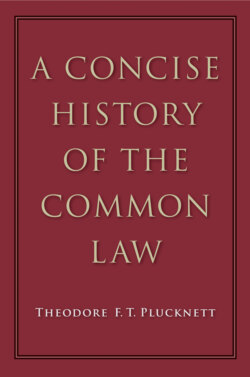Читать книгу A Concise History of the Common Law - Theodore F. T. Plucknett - Страница 144
На сайте Литреса книга снята с продажи.
THE EXCHEQUER OF PLEAS
ОглавлениеPerhaps the earliest example of competition between common law courts comes from the Exchequer. We have already mentioned the rise of this institution as an accounting organisation, and as an assembly of high officials who combined the audit of the royal accounts with the discussion of related problems as they arose.2 The development of a law court out of this purely administrative procedure can be clearly traced in the various series of rolls produced in the Exchequer.3 In its early days the Exchequer kept but one roll, the great roll of the pipe which contained detailed accounts. In the course of business there arose many matters which could not be immediately settled, and so such matters were removed from the pipe roll and reserved for further consideration, being entered on a new series of Memoranda Rolls created for the purpose. There are hints of such rolls under Henry II;1 they are known to have existed under Richard I, and one has survived for the first year of John (1199-1200).2 Some of the matters on these rolls called for judicial treatment, and so in time we find a further specialisation in the rolls. In 1220 we have a separate roll of pleas concerning the King’s Jews,3 and in 1236 we have the first roll of the Exchequer of Pleas.4 The revenue department had become a revenue court. This court, moreover, was essentially a common law court; it used the common law procedure, although in a more stringent form, and apart from revenue cases which formed the bulk of its work, it did useful service in permitting subjects to bring proceedings against officials (especially sheriffs) who had acted irregularly. Such a court was likely to win public sympathy, and although its rolls are not very bulky it seems to have been active.
In 1300 we find a statutory provision that no common pleas shall be heard in the Exchequer,5 and this is the first great attempt by one common law court to prevent another from competing with it. The Exchequer was in a position to offer substantial advantages to plaintiffs who resorted to it, since Exchequer process extended to Wales and the palatinates (where king’s bench and common pleas had no jurisdiction)6, simple contract debts could be recovered from executors,7 and wager of law did not lie. This latter rule raised protests in some quarters, and in 1376 wager of law was authorised by parliament (save where the King was party) in the Exchequer, on the ground that jury trial was to the great damage of the people and the impoverishment of the jurors, and caused much delay.8
There were several grounds upon which the Exchequer could hear “common pleas”—meaning thereby non-revenue cases. In the first place, the officials of the Exchequer and their servants were privileged: as plaintiffs they could compel their adversaries to answer in the Exchequer court, and as defendants they could refuse to answer save in the Exchequer. Secondly, merchants are frequent litigants in the Exchequer,1 and in some cases at least, the affairs of merchants, friars and other favoured persons were treated there because the King had so ordered.2 Furthermore, parties could voluntarily enrol recognisances of debt in the Exchequer records, and if they did so, then any resulting litigation would take place in the Exchequer. Then, too, many decedents died in debt to the Crown, with the result that executors and administrators were constantly before the court. Finally, any Crown debtor could invoke the Crown’s very effective machinery against his own debtors, by means of the allegation that by their remissness he was less able to discharge his own debt to the King. This principle is as old as the Dialogue of the Exchequer.3 The earliest cases show the King as co-plaintiff with his debtor against the debtor’s debtor;4 forms vary somewhat, but when the action succeeded, the debt was paid to the Exchequer and not to the plaintiff. There is no trace of the famous writ of Quominus under Henry III or Edward I,5 and the first example so far known is said to be in 1326.6
According to Blackstone7 the allegation of indebtedness to the King contained in the writ of Quominus was treated in his day as a fiction; curiously enough Coke and Hale are silent on this development, and so is Burton (writing in 1791). It is impossible to say when this fiction began.8
